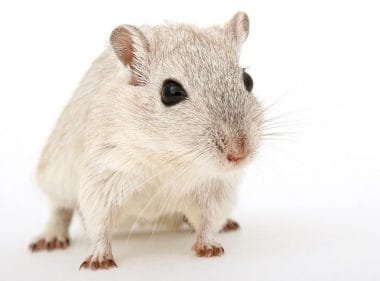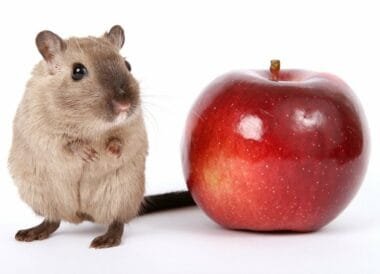Two of the most popular members of the rodent family, gerbils and mice are both great pets. These animals share many similarities in terms of their overall look, size, and more due to which they are often loved by many people. That being said, there are actually many things that are different when you compare these 2 cute pets.
Looking at it from a gerbil vs mouse perspective, knowing these differences can be very important to choose the right pet for you. Also, as you can’t keep both of these rodents together, finding the right fit for you is essential for keeping one as a pet. So, we have curated a list of the differences between gerbils and mice to help you out. Let’s get into it:
7 Differences between Gerbils and Mice
Gerbils have wider noses
One characteristic that can be added to the gerbil vs mouse distinction is their nose. Gerbils have wider noses and it is often of a lighter color than the surrounding fur. This is quite different from mice who have thinner noses that blend in with their color. So, while it isn’t really a basis for deciding on a pet, this is a great way to identify which animal you are looking at.
They behave differently
An important part of keeping a pet is the way the animal behaves. Some people like active animals that will keep you running all day while others prefer timid pets that will let you relax when needed. When it comes to gerbils vs. mice, they are both similar and different when it comes to behavior.
A unique characteristic of Gerbils is that they will use their long hind legs and frequently stand upright. They do this all the time and it can be for various reasons such as looking around or scanning for threats. On the other hand, mice rarely stand on their hind legs. While they are able to do so, their legs are much smaller and not suitable for standing up often.
Another big difference between the two is the amount that they dig. Gerbils are intense burrowers and will require a lot of bedding in their habitat to fulfil this need. They build complex systems and will spend a lot of time, indoors or outdoors, in these burrows. Mice are very different and while they do dig, their burrows are much smaller and simple.
Apart from this, however, both animals are very interactive and will make for great pets. As they live in groups in the wild, they are able to live in multiples indoors as well. So, for both of these naimals, you can keep them in pairs or groups so they don’t get bored. Moreover, both animals are known to be quite intelligent although mice are often said to be smarter than gerbil relatives.
The ears are very different
One of the most prominent characteristics of mice is their ears. They have large rounded ears which are prominently visible and improve their appeal greatly. While they may look good, these ears are also very useful to mice in their lives.
This is because the larger ears are used to improve their hearing, which is important at night. This helps mice in the wild react to threats quickly and understand their surroundings. Without their ears, mice wouldn’t be able to identify predators as easily in the wild which would be quite problematic.
On the other hand, gerbils are known to have much smaller ears. While they are still rounded and have a similar shape, their ears take up much less space which makes sense for these rodents. This is primarily due to the fact that gerbils are more dependent on their eyes. Thus, having large ears is not as useful for them as compared to mice.
When it comes to the debate of gerbil vs mouse, this is one factor that is up to you. If you like the larger rounded ears and thinks it adds to the look of the animal, mice are the way to go. On the other hand, if you find larger ears excessive on these small rodents, then you would be better off with a gerbil.
Mice have thinner tails
A well-known fact about rodents is that most of them have large tails. This is true for both mice and gerbils as well but their tails are slightly different from each other.
Mice tails are as long as their bodies and quite slim. Their tails also taper down as they go forward and get progressively thinner. Moreover, mice tails have minimal amounts of fur which is barely visible to the naked etc. Due to this, you will most often only see the pink skin of the mouse on its tail.
Gerbil tails are also the same length as their bodies but are much thicker than those of mice. Their tails maintain thickness throughout their length which is a great way to tell these animals apart. Also, gerbil tails have a lot more fur as compared to mice. This fur tends to be the same colour as their body and make the tailless skin-like and more like the rest of the animal.
Their fur/coat is different
While the differences in their fur have become less and less noticeable due to selective breeding, it is still something that sets them apart. Primarily, if you are looking into the natural colors of these animals in the wild, they are very different.
Gerbils in the wild are mostly found with sand colors coats similar to the environment they live in. This could be light brown, gold, or white in different patterns and designs. This is primarily due to evolution and helps them blend into their surroundings.
Mice also share some patterns and colors with gerbils but are more commonly seen with deeper brown and less flashy colors. Also, unlike gerbils, mouse bellies have much less color on their fur.
How much they smell
Probably a key factor in deciding which one you would keep as a pet, both of these animals create different amounts of ‘smell’. Mouse create large amounts of strong stench which is primarily due to their urine. As mice drink lots of water and have the tenancy to urinate wherever this builds u and can be quite a hassle if you have one.
On the other hand, gerbils also smell but this is much less than mice. They don’t drink as much water due to their natural habitat being in arid regions with less water. Due to this, they produce less urine and don’t require as much cleaning. So, if you are looking for a pet that doesn’t need as much effort and cleaning, gerbils would take this point for the gerbil vs mouse comparison.
Their natural habitat
Gerbils are most commonly found in desert regions across the world. This is also why they have many characteristics suitable for living with low water. One of the best examples of this would be that they drink much less water than many other rodents such as mice. This environment is also what gives them their sandy coat as it is perfect for blending in and hiding from predators.
Quite different from gerbils, mice live nearly everywhere in the world. They are able to adapt to various conditions and are present in both hot, cold, dry, and wet conditions. However, they are often not equipped for very extreme temperatures or regions such as the desert.
Which One Is Right For You?
After going through this list, it might be a bit easier to pick which animal suits you best. However, if you are still confused with the gerbil vs mouse dilemma, here is some advice on which one you should get.
If you have a large budget and are looking for a colorful pet that will keep you entertained, a gerbil is probably the one for you. These animals need lots of bedding in their habitat but once you have them set up, maintenance is a lot easier. They are also often more colorful and will be a great fit for your requirements.
On the other hand, if you don’t want to spend too much money and are willing to put in the effort for a fun friend, a mouse might be better for you. They don’t need as much bedding or an expansive habitat and are also quite intelligent animals. However, they do urinate a lot which means you’ll be cleaning their home quite often.
Conclusion
Summing it up, while these animals are quite different, they are both great pets and will be very enjoyable. You can use this list to help you make the final choice but you will surely have a great time with both of them. However, whichever pet you keep, make sure you provide it with ample entertainment and interaction as they both require stimulation for health. So, we would advise that you buy them in pairs (of the same species) instead of single pets.






